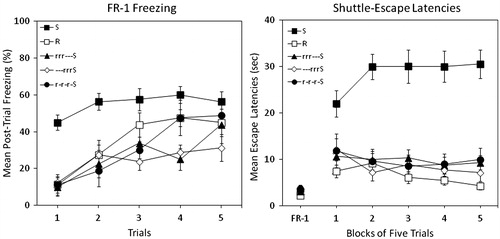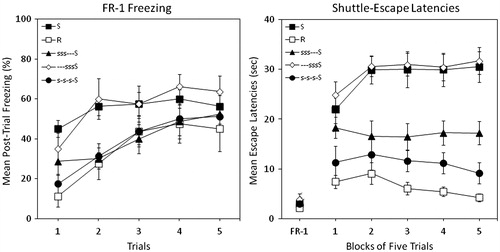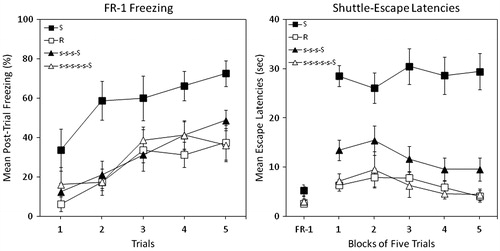Figures & data
Figure 1. Percent freezing (left panel) and shuttle escape latencies (right panel) for 6 groups in Experiment 1. Two groups were exposed to traumatic shock stress (Group S) or simple restraint (Group R). Two other groups were pre-exposed to 3 d of restraint with interpolated days of rest followed by either restraint or traumatic shock (Groups r-r-r-R and r-r-r-S). Two other groups were pre-exposed to 5 d of restraint with interpolated days of rest followed by either restraint or traumatic shock (Groups r-r-r-r-r-R and r-r-r-r-r-S). Shuttle-escape testing occurred 24 h later. Freezing was measured over five trials (FR-1) at the start of the shuttle-escape test. Impaired escape performance was assessed over the next 25 trials (FR-2).

Figure 2. Percent freezing (left panel) and shuttle escape latencies (right panel) for five groups in Experiment 2. Two groups were exposed to traumatic shock stress (Group S) or simple restraint (Group R). Three other groups were pre-exposed to 3 d of restraint followed by traumatic shock. These three groups received 3 d of rest that either preceded training (Group —rrrS), followed training (Group rrr—S), or was interpolated with training (Group r-r-r-S). Shuttle-escape testing occurred 24 h later. Freezing was measured over five trials (FR-1) at the start of the shuttle-escape test. Impaired escape performance was assessed over the next 25 trials (FR-2).

Figure 3. Percent freezing (left panel) and shuttle escape latencies (right panel) for five groups in Experiment 3. Two groups were exposed to traumatic shock stress (Group S) or simple restraint (Group R). Three other groups were pre-exposed to 3 d of 25 inescapable tail shocks followed by traumatic shock. These three groups received 3 d of rest that either preceded training (Group —sssS), followed training (Group sss—S), or was interpolated with training (Group s-s-s-S). Shuttle-escape testing occurred 24 h later. Freezing was measured over 5 trials (FR-1) at the start of the shuttle-escape test. Impaired escape performance was assessed over the next 25 trials (FR-2).

Figure 4. Percent freezing (left panel) and shuttle escape latencies (right panel) for four groups in Experiment 4. Two groups were exposed to traumatic shock stress (Group S) or simple restraint (Group R). Two other groups were trained with 3 or 5 d of 25 inescapable tail shocks with interpolated days of rest followed by traumatic shock (Groups s-s-s-S and s-s-s-s-s-S). Shuttle-escape testing occurred 24 h later. Freezing was measured over five trials (FR-1) at the start of the shuttle-escape test. Impaired escape performance was assessed over the next 25 trials (FR-2).

